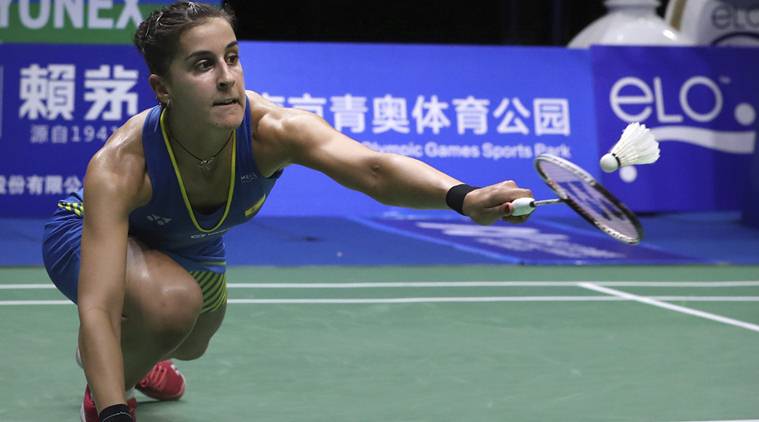 Sindhu leads Marin 6-5 in head-to-head matches but the Spaniard won the Rio Olympics final. (Source: AP)
Sindhu leads Marin 6-5 in head-to-head matches but the Spaniard won the Rio Olympics final. (Source: AP)
Carolina Marin has been learning Mandarin these last few months and has been on a charm-offensive in Nanjing this week. PV Sindhu, who won her first World Championship bronze in Guangzhou in 2013, is friends with the Chinese of the past – Wang Yihan and Wang Shixian, even meeting up with them before the World’s. Not that the locals needed wooing, but Marin and Sindhu have been a treat to the discerning Chinese spectators who love their badminton a touch more than they love their winners.
Standing ovations for Sindhu after she beat Yamaguchi, and a grudging applause for Marin who dinned her way to dousing Chinese hopes beating a tearful He Bingjiao, have meant it is poetic that China hosts the edition of the World Championships, which is a repeat of the Rio Olympic final. If anything, Marin has gotten more combustible, and Sindhu far more combative – add or subtract the shrieking and fist-pumping, which appeared to come as nothing short of a cultural shock for the psyched Bingjiao who wilted in the battle of the left-handers. If Rio was a far outpost for badminton’s Olympic showpiece, Nanjing is right at the heart of the sport, ready to applaud two fighters.
If Sindhu’s comeback from 12-19 was heartening for Indians, Marin’s come-from-behind win where she was a pugilist in a shuttler’s garb bruising the local challenger, set up an encore. But it needed the Rio duo to go head to head to top the Sindhu-Okuhara final from last year.
Sunday will be nothing like – that – Sunday. While the Olympic champion starts as a favourite – she decimated Nehwal and had the Chinese sobbing into a towel at the 11-break in the third – Sindhu has come out of two blazing battles, looking far sturdier than Rio.
“Close final. Marin is going to be aggressive, and it’s important Sindhu goes out there and gives it her best shot. We have a plan, let’s see, but I hope we can do it better this time than last time,” Gopichand said.
Back home, former players are sensing the tingling excitement based on Sindhu’s showing over the weekend business end of the meet. Marin brings with her more than the decibel of the aggression. Saina Nehwal had hit the nail on the head when she waved away the voluminous antics after her loss and got to the point. “It’s not the screaming. It’s the game she’s playing. At that pace, when you want to think about the next point, she’s not giving you time to think. I didn’t get any chance to attack,” Nehwal explained. Sindhu matched Marin’s pace at Rio, but there are a bagful of trucks up the Spaniard’s sleeve.
Former international Arvind Bhat stresses that though Sindhu got a lot of openings against the Japanese with the backhand net dribble, it will be nothing short of predictable to play cross to Marin who will pounce on it. “If the match goes close, it’ll be a big factor. Remember Sindhu’s cross back will go to Marin’s forehand (left-handed) and she won’t leave,” he warns, adding that Sindhu needs to be wary of Marin’s backhand flick.
Unlike Yamaguchi, Marin is quicker coming forward to the net – she charges like a bull in fact – and Aparna Popat reckons that Sindhu will need to switch tactics if the 25-year-old twice champion starts anticipating her on the forecourt. Also needing a rethink are the backhand pushes which caught the Japanese on their wrong side and played their part as ‘winning strokes.’ The southpaw will force the Indian to dump them as a go-to.
Marin’s patent crosscourt drop that dips at the net is mighty irritating and will be as huge a factor as her quick downward strokes. “If Sindhu doesn’t get her length, Marin will push her pace,” Popat says. Then, there are the fast-exchanges that the girl from Hueleva relishes – abrupt attacks from close range.
This leaves Sindhu with a few options – slowing down the pace or varying it at any rate. Plus, there’s a particular height Marin likes to strike the shuttle. “If the shuttle comes at her at an awkward upward angle, she’ll need to generate her own pace,” Popat adds. Not letting the Spaniard settle into any rhythm is the general plan, and Sindhu’s looked on course to execute it, baffling the Japanese. Three fast – one flat – one slow drop – or its permutations combinations.
Marin is expected to engage Sindhu at the net and then go for the bodylines. Two facets of Sindhu’s game have improved manifold since Rio: defense and variety in her strokes. “Marin plays dangerous downward strokes – I saw Sindhu play good attacking clears, so she has that choice. Carolina also moves fast towards the net, so anything to make her move diagonal,” Vimal Kumar adds.
Marin tends to be vulnerable when leading, and Sindhu has shown she’s not daunted by trailing. Still, how well the Indian can tackle those steep shots will be elementary to her defense. “This final will be Rio-esque. Sindhu is back to being aggressive (after her defensive phase which pushed her one step further), Marin is very fit,” Popat says.
The Chinese have been served up the best deal – short of having their own champion. The Chinese couldn’t win at Rio, but the Rio final has come to their home.